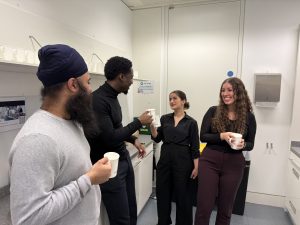Following our day in the life of a trainee solicitor in our Divorce & Family team, we speak to Kenza Sieber, a paralegal at Stewarts working in the Aviation department. We employ more than 100 paralegals across our London and Leeds offices to work on a one-to-one basis with the partners and associates.
In her role, Kenza assists fee earners with a range of case-related tasks and administrative support. This involves claimant-focused work on complex, high value matters helping pilots, crew, passengers and their families involved in air accidents abroad and disasters worldwide.
8:45
I arrive at the office ahead of our weekly Aviation team meeting at 9:30am. I stop by the kitchen to grab a coffee with my colleagues before heading to my desk to prepare for the meeting.
Each week I email the partners in my team with an update on my capacity for the week and whether I am currently meeting or exceeding my chargeable hours target. This helps the partners monitor workloads and allocate work effectively, and ensures transparency across the team.
This week, it is my turn to take notes in the meeting, so I prepare in advance. The paralegals in the team alternate this responsibility weekly.
I use the remaining 10 minutes before the meeting to draft a few emails, which my supervisor will review before they are sent to our client and an expert on the case.
Just before 9:30, I grab my laptop and notebook and head to the meeting room with the other paralegals.
9:30
Our team, comprised of two partners, a legal director, an associate and three paralegals, meets weekly to go through our case list. We discuss the progress made on each matter since the previous week and our strategy going forwards.
I leave the meeting with a clear understanding of my priorities for the week and the next steps in the litigation process for the cases I am involved in.
11:00
Back at my desk, I write a quick to-do list for the day.
One of our clients has an upcoming appointment with a medico-legal expert, so I will need to send the expert a letter of instructions along with relevant documents ahead of the appointment.
I review the client’s file to remind myself of how the expert’s specialty aligns with the client’s injuries and issues. This helps me adapt the instructions to ensure that the letter includes the necessary information, so that the expert can draft a report as tailored and relevant as possible to our claim.
Once I have completed the draft, I send it to my supervisor with a few comments for her review. In the meantime, I start compiling the documents that I will share with the expert into a secure confidential folder.
Once the folder is ready, I answer a few emails. I then take a short break to make tea and grab some fruit in the kitchen.
12:00
Next on my list is drafting court submissions for an upcoming inquest hearing. I conduct legal research and begin working on a first draft. I plan to review it with fresh eyes later in the day, before sending it to my supervisor.
13:00 
I meet with a few other paralegals from other teams and head to our weekly lunchtime yoga class.
Lunchtime yoga is a nice break which allows us to recharge and refocus before continuing with the rest of the workday. It is also a great way for us to catch up in a relaxed setting.
14:00
Back at my desk, I respond to a few emails before completing the next task on my list.
In one of our cases, we are issuing proceedings outside of the jurisdiction, which requires our pleadings to be translated. I review the file, gather the necessary documents and send them to a translation agency with instructions.
I then review my earlier draft submissions, make a few final amendments, and send them to my supervisor for review. These will later be passed to counsel to finalise.
15:00
We have recently issued proceedings in a separate case and received a Notice of Allocation from the court. This sets out the deadline for the parties to file their direction questionnaires with case summaries and proposed case management directions. The parties are expected to attempt to agree the case summary and proposed directions in advance, so early planning is needed. The partner on the matter has asked me to prepare the draft Costs and Case Management Conference (CCMC) documents by the end of the week.
I begin drafting the case summary and the claimant’s proposed directions and briefly look at the directions questionnaire, which I will aim to complete tomorrow. I have drafted documents like this before on a separate case, and therefore the process is a little easier. I will review and finalise all CCMC drafts tomorrow before sending them to my supervisor for feedback.
16:30
I receive the draft letter of instructions back with s tracked changes and a few comments. I review the feedback, finalise the letter and prepare the folder of supporting documents.
I send a draft of the covering email to my supervisor, and once approved, I send the email to the expert attaching the letter of instructions and enclosing a link to the supporting documents.
Before wrapping up, I draft a follow-up email to a witness to arrange a meeting in the coming weeks to take their statement.
17:45
Before leaving for the day, I review my to-do list to ensure that all urgent tasks have been actioned. I cross off completed items and add any new tasks that I need to complete later in the week, which helps me stay organised.
I then release my time entries on our tracking software before heading home.
Join our team
Paralegal vacancies arise from time to time in each of our departments, both in London and Leeds. Learn more and view our paralegal vacancies here.
Stewarts Career Stories
We encourage our people to strive for excellence in everything they do. Our culture promotes a good work/life balance and supports the career progression of our staff.
We’ve highlighted some of the careers of our people, outlining the diverse paths they have taken to get where they are today.




